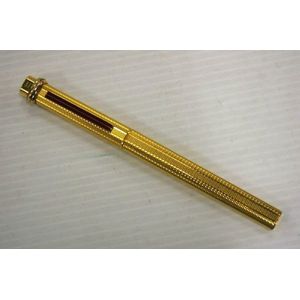EM Chapin Ivory Rule with Slide Caliper
You must be a subscriber, and be logged in to view price and dealer details.
Subscribe Now to view actual auction price for this item
When you subscribe, you have the option of setting the currency in which to display prices to $Au, $US, $NZ or Stg.
- Ivory - Ivory is a hard white material that comes from the tusks of elephants, mammoth, walrus and boar, or from the teeth of hippopotamus and whales. The ivory from the African elephant is the most prized source of ivory. Although the mammoth is extinct, tusks are still being unearthed in Russia and offered for sale.
Ivory has been used since the earliest times as a material for sculpture of small items, both in Europe and the east, principally China and Japan.
In Asia ivory has been carved for netsuke, seals, okimono, card cases, fan supports, animals and other figures and even as carved tusks.
In the last 200 years in Europe ivory has been used to carve figures, for elaborate tankards, snuff boxes, cane handles, embroidery and sewing accessories, in jewellery and as inlay on furniture. Its more practical uses include being used for billiard balls, buttons, and a veneers on the top of piano keys.
The use and trade of elephant ivory have become controversial because they have contributed to Due to the decline in elephant populations because of the trade in ivory, the Asian elephant was placed on Appendix One of the Convention on International Trade in Endangered Species (CITES), in 1975, and in January 1990, the African elephant was similarly listed. Under Appendix One, international trade in Asian or African elephant ivory between member countries is forbidden. Unlike trade in elephant tusks, trade in mammoth tusks is legal.
Since the invention of plastics, there have been many attempts to create an artificial ivory
This item has been included into following indexes:
Visually similar items

Three Victorian walking sticks, 19th century, including a turned and carved whalebone walking stick, an 18 ct. gold mounted wooden walking stick and a green twisted glass walking stick (3), approx height 90 cm

Cartier Vendome gold plated floating ball pen, 13.5 cm long

Japanese Tanto, Reshaped katana blade, 32 cm long single edge with fuller along back edge from copper hibachi to run out at reshaped tip. Unsigned cut down tang. Hilt tape boundary skin with single silver menuki, kashira missing. Old heavy square tsuba, do

Koto period Katana attributed to Su Mihara dated pre 1596, unsigned but attributed to Su Mihara by Nbthk Hozon Kanteisho, circa 1550. in full Japanese polish. Blade curve, straight temper line & well aged original tang are typical of the late Muromachi per
